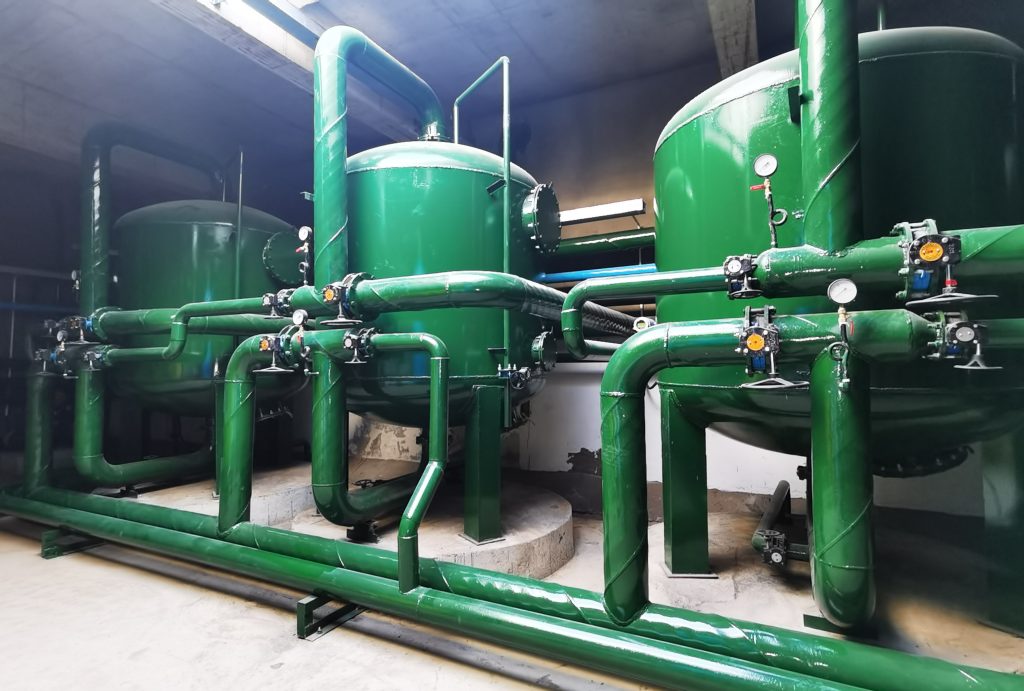Everything you need to know about industrial sand filters
Industrial sand filters are commonly used for removing suspended solids from the water using a single-size filtration media. The filtration process can be decided by adjusting the size of the filter sand. The ideal size of each granule usually varies from 0.35mm to 1.2mm.

Industrial sand filters can have graded support media layers or be directly installed over or on a distribution plate. This water treatment technique can also be combined with other filtration techniques such as activated carbon. Let’s help you understand more about Industrial Sand filters, their advantages, disadvantages, and how they actually work.
What Is An Industrial Sand Filter?
As the name suggests, sand filters are filled with sand, commonly used for different industries. The sand of different particles is stored in a sand filter, and the bottom of the sand filter contains porous double bottom – collector. The sand is often found in a mild-steel, plastic, or concrete housing.
What is Multi-Media Sand Filters?
Multi-media sand filtration are another industrial sand filter solution. It is performed to remove suspended solids of finer sizes. These filters usually have multiple layers of filter media, which gathers removed finer particles and solid loading. A typical multi-media sand filter has three layers of filling such as anthracite, gravel, and sand.
How Does Industrial Sand Filtration Work?
Industrial sand filters can filter particles down to 10 to 25 microns and achieve at least 5-micron filtration depending upon filter vessel sizing and arrangement. When water flows down the bed, it experienced different layers of filtration media. It is known as multi-media sand filters. Eventually, smaller particles are removed by each layer which provides accurate depth filtration and typically increases the filter capacity.
The various biological and physical processes can also be used in a sand filter that can remove more components. The particles will be collected in the upper layer of the sand filter. To prevent a clogged filter, the water filtration experts will backwash the filter in which extracted particles are flushed out so that the filters can be reused again.
Sizing of Industrial Sand Filter
Some custom industrial sand filter experts can support your project from start to end. Different industrial sand filters are used based on the properties of the process that needs water treatment. Following are the factors that can help in determining the size of industrial sand filters:
Concentration of solids
Lower sand filter loading rates and large diameter vessels are needed with higher suspended solid concentrations.
Discharge limit and destination
The effluent concentration required in the process stream can help in determining the filter vessel’s size. The vessel diameter can increase as the restrictions get tighter for discharge allowances.
Source of backwash water
Filter backwashing is generally utilized to flush out the suspended solids that were removed in the media bed. The cycle can be self-source or outside-source. On the one hand, self-sourced backwashing uses water that is filtered by the duty filters, while outside-source uses an external source of water like a storage tank.
Size of particles that needs to be filtered
The loading rate needed to filter solid particles from the process has to be lower for small-sized solids.
Advantages of Industrial Sand filters
Below are some of the key advantages industrial sand filters offers:
Removal of various floating particles
Effective result in the reduction of bacteria and protozoa
Low maintenance and easy to operate
Longer life span and effective removal of particles
Disadvantages of Industrial Sand filters
Industrial sand filters offer many advantages; however, it has a few cons which one should consider:
Transport can be difficult for heavy filters
Small fine dust can be tough to remove
Maintenance
As industrial sand filters extract turbidity from incoming water flow, the filter will show a high-pressure drop across the bed. Thus, it requires a backwash to clean the bed.
The backwash has to be performed once the pressure drop across the bed drops below a target threshold. A standard pressure drop ranges between 3 to 7 PSI, so it has to be considered before initiating a backwash.
A backwash should be performed each time the media reaches capacity which should be about once a week for a properly designed system.
The jagged edges of sand and media can become rounded over a long time, and thus, reduces the filtration ability after some years of service and need to be replaced.
